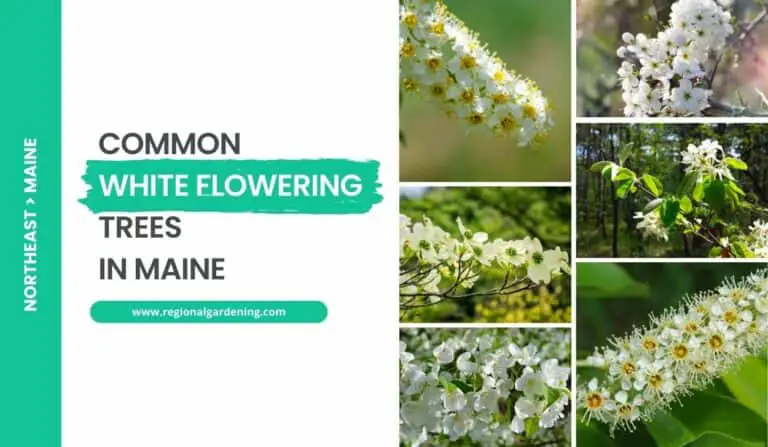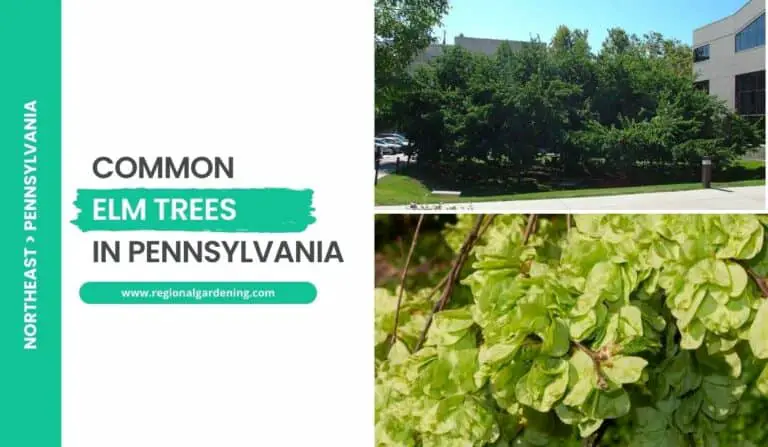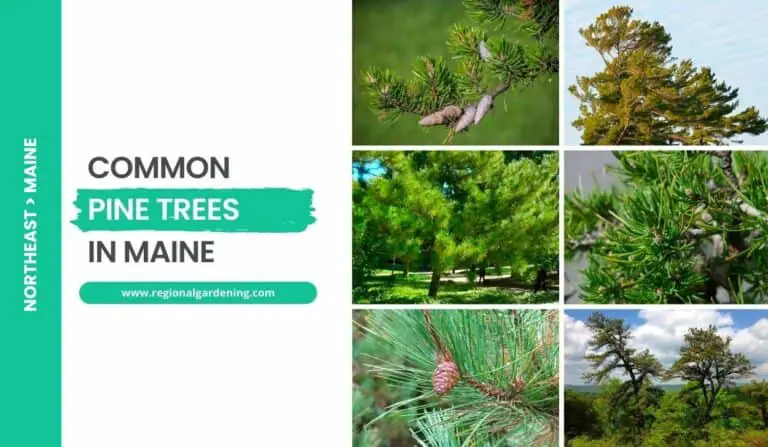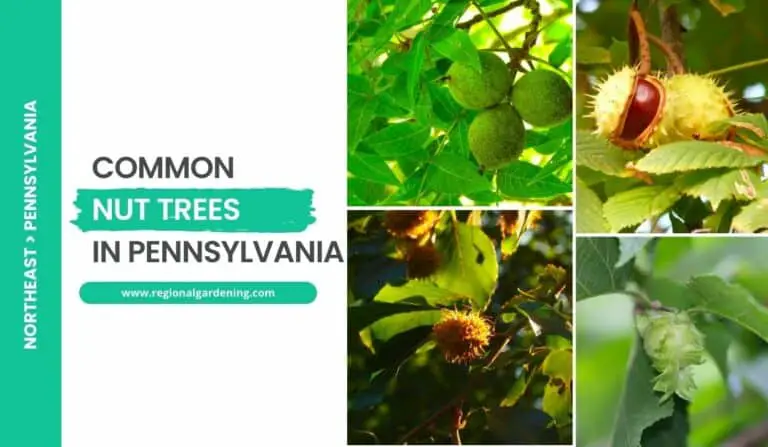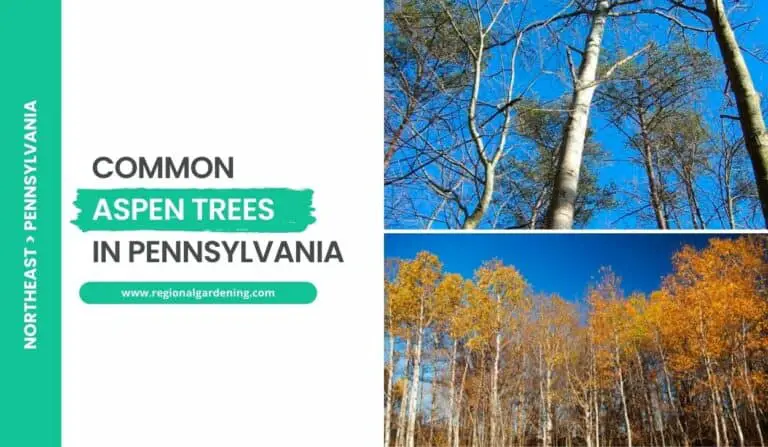3 Common Cedar Trees In Maine (Photos & Identification)
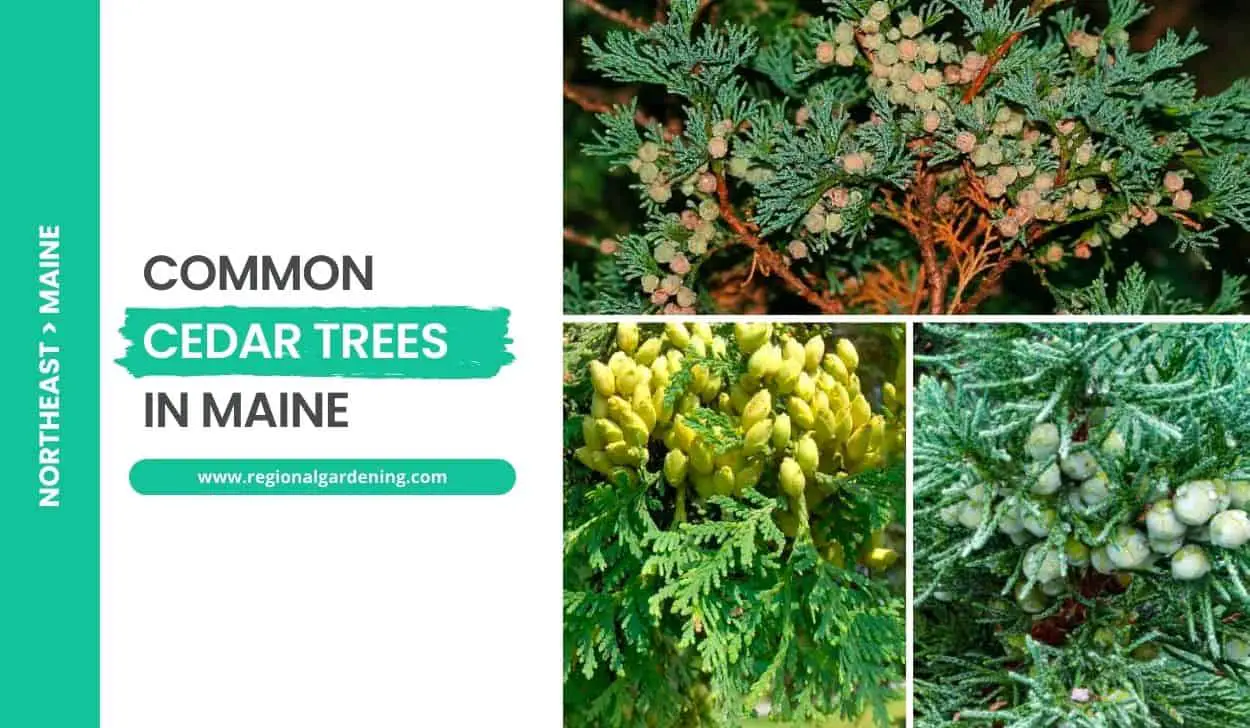
The stately presence of cedar trees adorns Maine’s wild and untamed landscapes.
These hardy evergreens not only add a touch of natural beauty to the landscape, but they also have cultural and ecological significance. Cedar trees are an important part of the state’s ecosystem, from their aromatic branches used in wreaths and crafts to their ability to stabilize soil and provide habitat for birds.
In this article, we will go through the three common cedar trees in Maine, diving into their unique characteristics, common uses, and the unique charm they bring to the rugged beauty of the state.
So, let’s begin.
1. Atlantic White Cedar
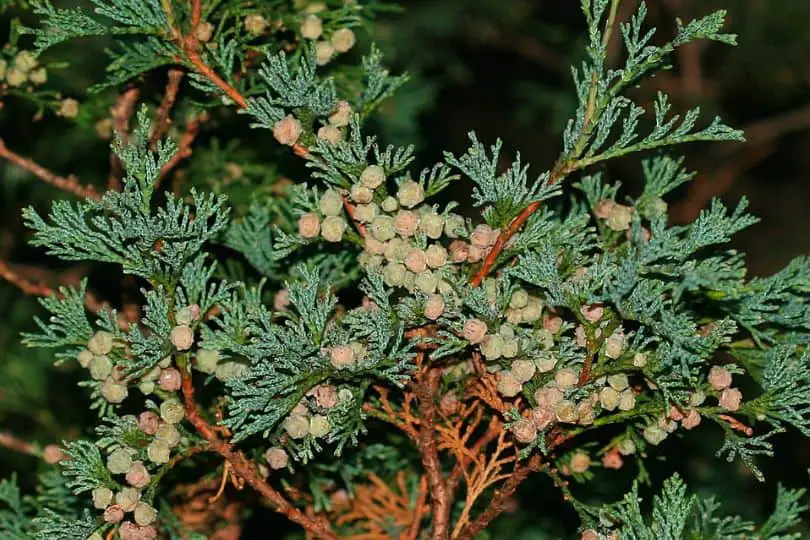
- Scientific Name: Chamaecyparis thyoides (L.) B. S. P.
- Common Name: Atlantic White-Cedar
- Mature Height: Rarely exceeds 40 feet (12 meters)
- Native Region: Eastern United States
- Flowers: No Flowers
- Fruit: Small, round, smooth cones, about ¼ inch in diameter, purplish before maturity
- Uses: Fragrant wood, limited use due to brittleness, shavings used for dog bedding
The Atlantic White Cedar, Chamaecyparis thyoides, is one of the commonly found native cedar trees in Maine. It is typically found in bogs or low regions around ponds or streams in Maine, including Appleton’s Newbert Pond, Northport’s Knight Pond, and the southern parts of Cape Elizabeth extending through York County. This particular cedar species grows to a maximum height of 40 feet.
Because of its gradually tapering trunk and short branches, the Atlantic White Cedar has a conical look. It has somewhat flattened twigs and fibrous bark that ranges in color from whitish to reddish-brown.
The bark frequently has twisted spirals and can be readily peeled off in sections, especially on young trees. The bluish-green leaves of the tree are scale-like and grouped in fan-shaped clusters. The crushed leaves have a nice scent.
The cones of the Atlantic White Cedar are small, spherical, and smooth. Before maturing, these cones are about 14 inches in diameter and have a purplish tint. Throughout the winter, the cones remain on the tree but are not visible. This cedar species’ wood is light, close-grained, and intensely aromatic. It’s a light brown with a crimson tinge to it. However, because of its brittleness, the wood has limited use. The cedar shavings, on the other hand, are used as dog bedding.
Caring for Atlantic white cedar trees in Maine landscapes entails providing an appropriate growing habitat. It prefers damp environments, such as bogs or low-lying places near ponds or streams. A sufficient quantity of water is critical for its health and growth. While it can withstand some drought, it flourishes best with continuous hydration. Furthermore, the tree is low-maintenance and requires little pruning.
The aromatic wood of the Atlantic White Cedar is used for a variety of purposes. However, because of its brittleness, it is not widely employed in construction or woodworking. Furthermore, the wood is light in weight. In addition, Atlantic White-Cedar shavings are used as dog bedding, benefiting from the tree’s distinct smell.
2. Northern White Cedar
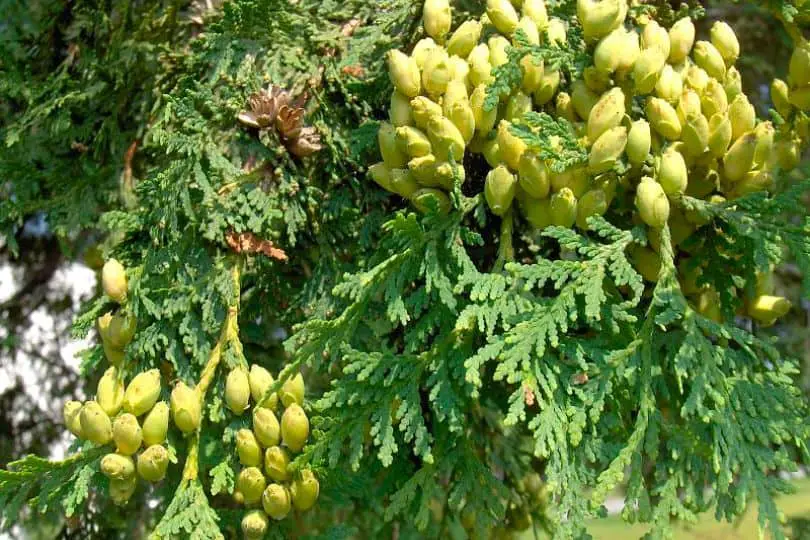
- Scientific Name: Thuja occidentalis L.
- Common Name(s): Northern White-Cedar, Eastern Arborvitae
- Mature Height: Up to 60 feet (18 meters)
- Native Region: Eastern North America
- Flowers: No Flowers
- Uses: Ornamental, shingles, cooperage, poles, posts, fencing, lumber, decking, outdoor furniture
Northern White Cedars are the tallest cedar trees in Maine and can reach a height of up to 60ft. It is sometimes known as Eastern Arborvitae and can be found in marshes, along streams, on mountain slopes, and in ancient pastures. It is particularly common in the state’s northern and eastern regions. This tree grows best in damp soil, especially alkaline soil.
The crown of the Northern White Cedar is compact, thin, and pyramidal in shape. It has short, horizontal branches that tend to slope upward. The tree can reach a height of 60 feet and a diameter of 3 feet. The trunk frequently has strong buttresses. The bark is reddish-brown with shallow fissures that divide it into flat, narrow ridges that are occasionally tinged with orange.
Northern White-Cedar leaves are scale-like and just around 1/8 inch long. They are placed in opposing or two-ranked rows, giving the little branches a flat look. When crushed, the leaves emit a nice, aromatic odor and have a mildly agreeable flavor.
This cedar tree’s cones are small, upright, and around 12 inches long. They just have a few pairs of scales and mature in one season. The seeds are winged and tiny.
The wood of Northern White-Cedar is soft and light, with a coarse texture and a pleasant odor. It has a very strong heartwood. This wood has traditionally been used for shingles, slack cooperage, poles, posts, rustic fences, and a variety of lumber applications such as boxes, crates, and siding.
Because of its natural weather-resistant characteristics, it has recently acquired favor as an alternative to pressure-treated wood. Cedar is often utilized in the construction of decks and outdoor furnishings.
For Maine landscape maintenance advice, it is critical to keep the soil continuously moist, especially during dry summers. Northern White Cedar can withstand rainy circumstances, making it an excellent choice for planting near streams or in areas with poor drainage. Watering regularly, especially during dry spells, is good. Because this tree favors alkaline soils, testing and amending the soil as needed can help it develop.
Furthermore, giving some cover from severe snow accumulation, particularly for younger trees, can help to prevent branch damage.
3. Eastern Red Cedar
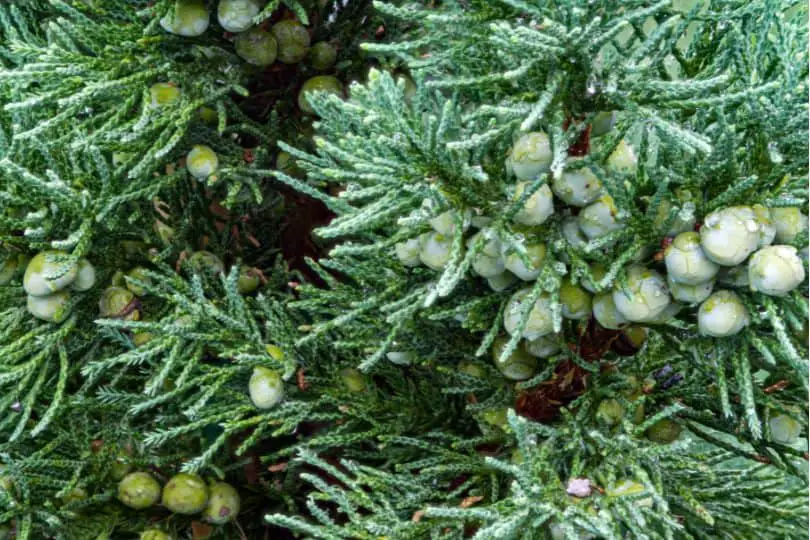
- Scientific Name: Juniperus virginiana L.
- Common Name(s): Eastern Redcedar
- Mature Height: 30 feet (9 meters)
- Native Region: Eastern North America
- Flowers: No Flowers
- Fruit: Berry-like, globose, 1-2 seeded, pale green when young, dark blue when ripe
- Uses: Valuable for fence posts, cabinet making, and pet bedding.
The Eastern Redcedars are the shortest cedar trees in Maine. It is native to Eastern North America and can be found in southern Maine on occasion, particularly in Bridgton, Porter, Denmark, and West Gardiner. It prefers poor soils, gravely slopes, rocky ridges, and damp sandy grounds to flourish.
The habit of this tree varies greatly, with young trees having slender horizontal limbs and a small, compact, conical head. The crown of the tree grows wider and more rounded as it matures. Eastern Redcedar trees in Maine normally grow to a diameter of 8 to 12 inches and can reach a height of 30 feet (9 meters).
On older trees, the bark on the trunk of the tree is light brown with a reddish tinge and separates into long, narrow shreds. Eastern Redcedar leaves are scale-like, dark green, and overlap one other. They are approximately 1/16 inch long and live on the tree for 5-6 years. In cross-section, the branchlets seem square. This tree’s current growth and vigorous shoots have sharp-pointed, awl-shaped leaves, which are known as “juvenile” growth.
Eastern Redcedar yields little berries-like fruit. These fruits are pale green at first but turn dark blue as they develop. They have 1-2 seeds and are about the size of a pea.
Eastern Redcedar wood is widely recognized for its durability, lightness, and pleasant aroma. It’s brittle, fine-grained, and easy to work, making it ideal for fence posts and cabinetry. However, it is not abundant enough in Maine to be commercially relevant. Furthermore, the shavings of this species are utilized as pet bedding.
Similar Articles
- Common Spruce Trees In Maine
- Common Oak Trees In Maine
- Common Ash Trees In Maine
- Common Birch Trees In Maine
- Common Maple Trees In Maine
- Common Pine Trees In Maine
- Native Aspen Trees In Maine
- Native Hickory Trees In Maine
- Common Cherry Trees In Maine
- White Flowering Trees In Maine
Common Cedar Trees In Maine – Sources
The Regional Gardening team makes sure that the information in our articles is accurate by only using sources that are known to be trustworthy. Some of these sources are peer-reviewed journals from government agencies, well-known universities, and scientific research organizations.
- Forest Trees of Maine, Maine Department Of Agriculture, Conservation & Forestry
- Identify Maine’s Common Foliage Trees, Maine Foilage
- Plants for the Maine Landscape, University Of Maine Cooperative Extension.
- Gardening to Conserve Maine’s Native Landscape, University Of Maine Cooperative Extension



